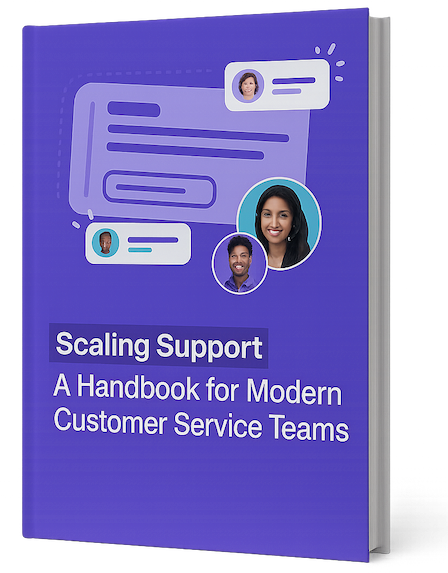Building a Data-Driven Customer Service Foundation

Delivering great customer service requires understanding what really matters to your customers, not just relying on gut feelings. To achieve this, you need to systematically track and analyze key metrics that reveal how well you're serving customers and where you can improve. Getting this foundation right is essential – studies show that 45% of customers will abandon a brand after just a few negative experiences.
Key Metrics for Measuring Customer Service Success
Several essential metrics give you clear insights into the quality of your customer experience. By carefully tracking these indicators, you can spot both strengths and areas needing improvement in your support strategy:
-
Customer Satisfaction Score (CSAT): This metric directly tells you how happy customers are with specific interactions or their overall experience. For example, if your CSAT drops sharply after rolling out a new product feature, it may signal usability problems that need fixing.
-
Net Promoter Score (NPS): NPS measures how likely customers are to recommend your brand to others. Research shows that companies who actively track NPS often grow faster – with studies finding 60% see accelerated growth compared to competitors who don't measure it.
-
First Response Time (FRT): Quick responses matter deeply to customers. A study found that 72% expect to hear back within 30 minutes. Taking too long leads to frustration and risks losing customers, making response time a critical metric to monitor.
Turning Data Into Actionable Insights
Simply having data isn't enough – you need to use it to make real improvements. This means looking for patterns and trends that can guide better decisions about your customer service approach.
For instance, if you notice lots of support tickets about one specific product feature, that's a clear sign something needs to change. Maybe the feature is too complicated or needs better documentation. You can also analyze how FRT connects to CSAT – do faster responses actually lead to happier customers? These insights help you focus on changes that will most improve the customer experience. You might be interested in: How to master…
Avoiding Common Data Pitfalls
While metrics are vital, certain common mistakes can derail your efforts. One frequent error is focusing on shallow metrics, like social media likes, instead of meaningful measures of customer happiness. Another mistake is failing to look at different customer segments separately – new customers often have very different needs than long-term ones.
Remember that while data should guide your decisions, it shouldn't override human judgment and empathy. The best approach combines rigorous measurement with genuine understanding of your customers' needs. This means regularly evaluating what you measure and how you use that information to help your team deliver better service. When done right, this balanced strategy builds customer loyalty and helps grow your business.
Mastering the Art of Personal Connection at Scale

The foundation of excellent customer service begins with smart data collection and analysis. This information becomes truly valuable when used to create genuine connections with customers at every interaction point. Research shows this personalized approach matters – 80% of customers actively seek customized experiences when interacting with businesses.
Why Personalization Matters in Customer Service
Real personalization goes beyond simply using a customer's name – it's about truly understanding and responding to their unique needs. Consider a customer reaching out about a software issue. Rather than giving a generic response, effective support would acknowledge their past experience with the product, understand their frustration, and provide solutions specific to their situation. This targeted approach has real impact – studies show 76% of customers feel annoyed when companies fail to personalize interactions. It's no surprise then that 77% of customers prefer brands offering personalized service and are willing to pay more for it.
Implementing Authentic Personalization
The key to effective personalization is making it feel natural, not automated. This starts with training your support team to pick up on important details during customer conversations. Teaching representatives to actively listen for clues about a customer's background, goals and pain points allows them to provide more relevant and helpful responses. When team members have easy access to customer history and preferences, they can engage in ways that feel personal and genuine.
Tools and Strategies for Personalization at Scale
Delivering consistent personalized service as you grow requires the right systems in place. CRM platforms help organize customer data and track interactions to identify individual needs. AI chatbots can provide customized greetings and recommend solutions based on customer profiles. But technology alone isn't enough – thorough training helps teams use these tools effectively to make every interaction valuable, even with high volume. This focus on personalization directly improves customer loyalty and satisfaction. For instance, proactively reaching out based on past purchases shows customers you understand and care about their needs. By investing in smart personalization, companies build stronger relationships that drive long-term growth.
Balancing AI and Human Touch in Customer Service
The personal touch in customer service we discussed creates a strong foundation for building great experiences. By thoughtfully adding AI capabilities, we can amplify these human elements rather than replace them. Success comes from finding the right blend – using technology to handle routine tasks while preserving authentic human connections where they matter most.
Selecting AI Tools That Match Your Needs
The first step is identifying your specific customer service challenges. For example, if customers face long wait times, AI chatbots can quickly answer common questions so human agents can focus on complex issues. For teams wanting to provide more personalized support at scale, Salesforce found that 56% of companies now use AI chatbots to manage customer interactions more efficiently. However, the tools themselves won't solve everything – what matters is implementing them strategically based on your goals.
Preparing Your Team to Work With AI
Getting the most from AI requires helping your team adapt to working alongside these new tools. This means thorough training on using the technology effectively and positioning AI as a helpful assistant rather than a replacement. For instance, agents need to know how to interpret AI-generated customer insights and smoothly transition between automated and personal interactions. When teams see how AI handles repetitive tasks and provides useful data, they're more likely to embrace it as a partner in delivering better service.
Keeping the Personal Connection
While AI brings powerful capabilities, genuine human interaction remains essential. The key is using AI for what it does best – like providing quick answers to basic questions and 24/7 availability – while having human agents handle situations requiring empathy and nuanced problem-solving. Think of AI as the engine powering efficient service delivery, with human agents steering interactions to ensure they stay personal and truly helpful. Research shows 64% of customers prefer AI messaging for simple issues over phone calls, highlighting how AI excels in specific contexts while reinforcing the need for human support in more complex situations.
By thoughtfully combining AI efficiency with authentic human connections, you can create customer experiences that drive loyalty and strengthen your brand. When implemented with care and purpose, this balanced approach has helped companies improve efficiency by 30% on average while maintaining high-quality personal service. And as AI technology continues advancing, there will be even more opportunities to enhance how we serve customers through this collaborative human-AI partnership.
Creating Lightning-Fast Response Systems That Work

The combination of a personal touch and rapid response creates exceptional customer service. Speed matters – customers expect quick solutions to their problems. In fact, studies show that 90% of consumers consider an immediate response essential for customer service inquiries, with 60% defining "immediate" as 10 minutes or less. But rushing through customer issues often leads to mistakes that damage satisfaction in the long run.
Balancing Speed and Accuracy in Customer Service
Finding the sweet spot between fast responses and quality service is crucial. While customers want quick replies, they also need accurate, helpful information. The solution lies in smart workflows that let your team work efficiently without cutting corners. For instance, having pre-written responses for common questions can speed things up, but agents need flexibility to customize them for each customer. A well-organized knowledge base also helps agents find answers quickly and confidently. Think of it like a racing pit crew – they can service cars rapidly because they have all the right tools and information ready to go.
Empowering Your Team for Efficient Responses
Building a responsive customer service system starts with empowering your team. Clear communication channels and defined roles help route questions to the right expert quickly, preventing delays from bouncing customers between multiple agents. Regular training on products, procedures and communication keeps skills sharp. Like an experienced chef who can prepare dishes quickly and perfectly because they've mastered their craft, ongoing skill development helps agents solve problems faster and more effectively.
Managing High-Volume Periods Without Compromising Quality
High-volume periods like product launches and holidays present unique challenges but are crucial moments to demonstrate excellent service. Strategic staffing with temporary agents or extended hours helps handle increased demand. A tiered support system, where chatbots or junior agents handle basic questions, lets senior agents focus on complex issues. Just as hospitals prioritize cases based on severity, this approach ensures every customer gets appropriate help without overwhelming your team. Making it through busy periods while maintaining quality service builds trust and demonstrates your commitment to customer satisfaction.
Transforming Data Into Proactive Customer Care

Companies are moving beyond just responding to customer issues after they happen. With data and analytics, support teams can now spot potential problems before customers even report them. Recent studies show that 73% of consumers now look for this kind of seamless, anticipatory service. Let's explore how you can make this shift in your customer service approach.
Understanding the Power of Predictive Analytics
By analyzing past customer behavior patterns, businesses can better anticipate and address needs early. This means going deeper than basic satisfaction scores to understand why customers take certain actions. For example, if you notice a customer frequently checking help documentation for a specific feature, you can proactively reach out with assistance before they need to contact support. You might send a personalized email or have a chatbot offer relevant tips. This kind of early intervention helps prevent customer frustration before it starts.
Implementing Proactive Service Strategies
To put data insights into practice, you need a clear plan. Start by creating systems that flag potential issues early. When customer usage suddenly drops, for instance, your team can automatically check in to ensure everything is okay. Most customers appreciate this kind of thoughtful outreach when done properly. Consider customizing your approach based on user type – new customers might benefit from detailed walkthroughs, while experienced users may prefer quick tips. This personalized attention builds stronger relationships over time.
Examples of Proactive Customer Care in Action
Picture a software company spotting users having trouble with a new feature. Rather than waiting for help tickets to pile up, they send targeted video tutorials to those specific users. Or consider an online store noticing someone repeatedly abandoning their shopping cart – a well-timed chat message offering help or a small discount could save the sale. These examples show how proactive support creates positive customer experiences, not just prevents problems.
Building Proactive Service Capabilities: A Step-by-Step Guide
Start building proactive support by identifying key signals that suggest customers need help – things like website navigation patterns, product usage data, and support ticket trends. Then create automated workflows to trigger outreach based on those signals. Make sure your team has proper training to deliver this proactive help effectively, whether through email, chat, or phone. Keep tracking results and refining your approach based on what works best. This ongoing process lets you steadily improve how you serve customers and deliver consistently good experiences.
Building a Customer-First Service Culture That Lasts
Great customer service starts with your team's culture and values – not just tools and metrics. Creating lasting customer-centric service requires thoughtfully developing your team's mindset and capabilities through several key strategies.
Hiring for Service Excellence
The foundation of customer-focused service starts with bringing on the right people. Look for candidates who naturally demonstrate empathy, strong communication abilities, and genuine desire to help others solve problems. Rather than focusing solely on technical skills that can be taught later, prioritize these core service traits during interviews. For example, someone who patiently listens and shows understanding when a customer is frustrated will create better experiences than someone who jumps straight to technical fixes. Design your interview process around scenarios that reveal how candidates handle customer-focused situations while assessing their emotional intelligence and problem-solving approach.
Developing Emotional Intelligence Across Your Team
While hiring naturally empathetic people is important, ongoing emotional intelligence training helps your entire team grow stronger service capabilities. Focus on building skills like active listening, emotion recognition and management, and customer rapport. Think of it like athletic training – customer service teams need regular practice to improve their emotional abilities. Use role-playing exercises, communication workshops, and consistent feedback sessions to reinforce positive service behaviors. This investment in emotional intelligence directly improves customer satisfaction and reduces friction.
Maintaining High Standards as You Scale
As teams grow larger, keeping customer-first culture consistent becomes more challenging. Clear service standards and guidelines help align everyone's approach, but avoid rigid scripts that prevent genuine customer connections. Think of these standards more as helpful guardrails than strict rules – they provide guidance while allowing flexibility to uphold core values. Regular communication and reinforcement of customer-focused principles helps maintain alignment as the team expands. Like a successful sports team preserving its winning culture through ongoing coaching, customer service organizations need sustained attention to maintain excellence.
Aligning Your Organization Around Customer Success
True customer focus can't live in the service department alone – it requires commitment across the entire company, from product development to marketing to sales. When every team understands how their work impacts customer experience, it creates unified dedication to great service. For instance, when product teams regularly hear customer pain points from support staff, they can address those issues in future updates. This cross-team collaboration strengthens the whole customer journey. Setting up effective feedback systems for both customers and employees helps continuously spot areas for improvement and keeps everyone focused on evolving customer needs. By creating an environment where exceptional service comes naturally, companies build lasting customer relationships that drive growth.
Ready to empower your customer service team and create exceptional customer experiences? Try SupportMan today and see how seamlessly integrating Intercom ratings into Slack can transform your support operations. Start your free trial now, no credit card required: https://supportman.io


